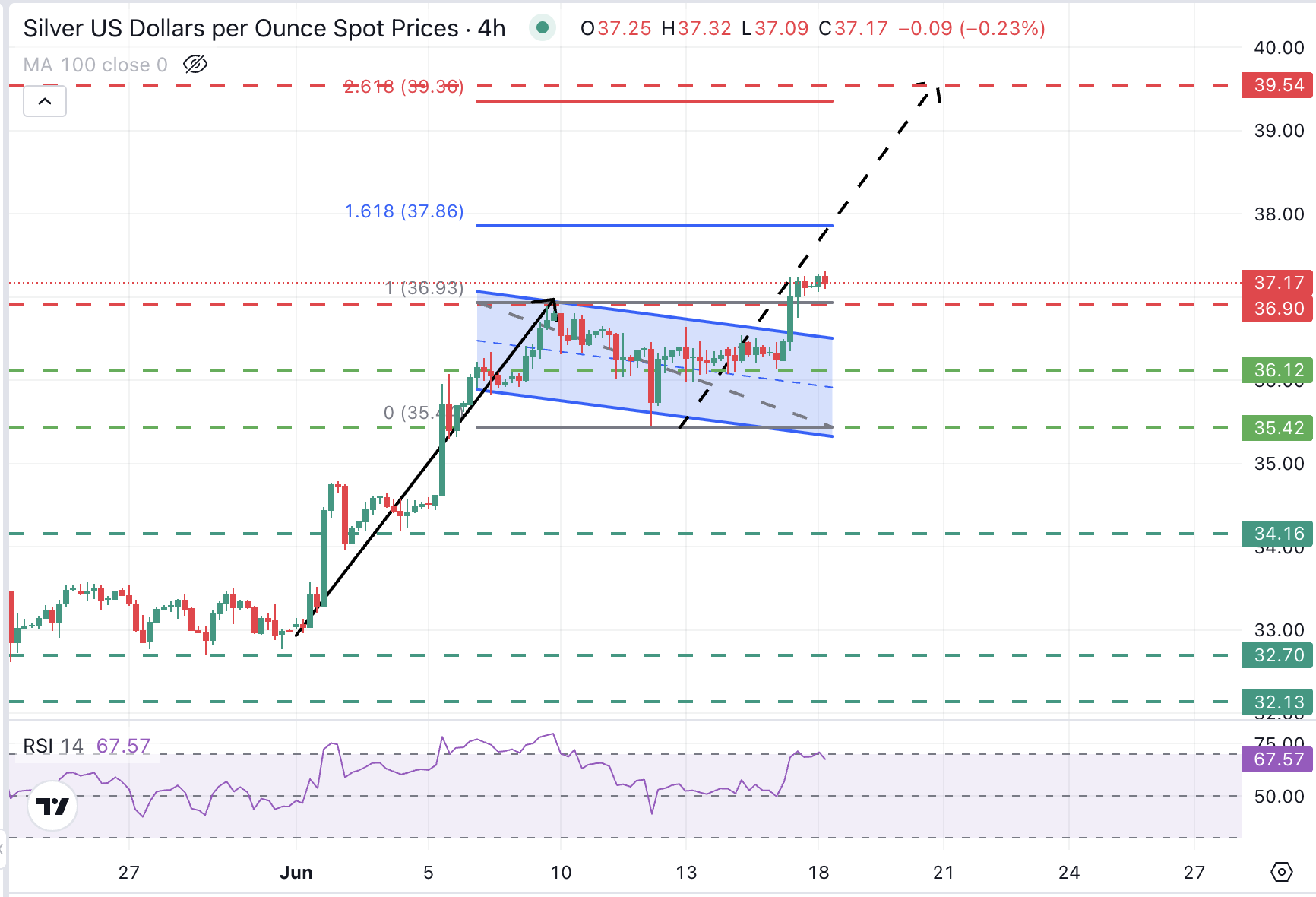Silver Price Forecast: XAG/USD breaks above $36.90, confirms a Bullish Flag
- Silver breaks above $36.90 and resumes its broader positive trend.
Precious metals rally on safe-haven demand amid geopolitical tensions.
XAG/USD's next resistance area is now at $37.85.
Silver (XAG/USD) broke above the top of a descending channel from early-June highs, favoured by higher safe-haven demand on risk-off markets, and has confirmed a bullish flag.
The fundamental context remains supportive with safe assets favoured as the war between Israel and Iran extends, with the US President Trump tempted to jump in and turn it into a regional conflict of unforeseeable consequences. Precious metals are likely to remain buoyant until geopolitical tensions ease.
The focus today is on the Federal Reserve, which is highly likely to keep interest rates on hold but will release fresh economic and interest rate projections that may have a significant impact on the US Dollar.
XAG/USD: The next resistance is at $37.85
From a technical perspective, the 4-hour chart shows that the pair ended its correction from June 9 highs on Tuesday, breaking above the $36.90 level and resuming the broader bullish trend
The next resistance level is now at the 161.8% Fibonacci extension of the June 9 to June 11 correction is at $37.85. Above here, the next target is the area between the 261.8% extension of the mentioned range, at $39.35, and the Bullish Flag’s measured target, at $39.55.
The 4-Hour RSI is reaching overbought levels, which might lead to some consolidation or a correction. The previous resistance, at $36.90, and the reverse trendline, now at $36.50, are likely to act as support.
XAG/USD 4-Hour Chart

Silver FAQs
Silver is a precious metal highly traded among investors. It has been historically used as a store of value and a medium of exchange. Although less popular than Gold, traders may turn to Silver to diversify their investment portfolio, for its intrinsic value or as a potential hedge during high-inflation periods. Investors can buy physical Silver, in coins or in bars, or trade it through vehicles such as Exchange Traded Funds, which track its price on international markets.
Silver prices can move due to a wide range of factors. Geopolitical instability or fears of a deep recession can make Silver price escalate due to its safe-haven status, although to a lesser extent than Gold's. As a yieldless asset, Silver tends to rise with lower interest rates. Its moves also depend on how the US Dollar (USD) behaves as the asset is priced in dollars (XAG/USD). A strong Dollar tends to keep the price of Silver at bay, whereas a weaker Dollar is likely to propel prices up. Other factors such as investment demand, mining supply – Silver is much more abundant than Gold – and recycling rates can also affect prices.
Silver is widely used in industry, particularly in sectors such as electronics or solar energy, as it has one of the highest electric conductivity of all metals – more than Copper and Gold. A surge in demand can increase prices, while a decline tends to lower them. Dynamics in the US, Chinese and Indian economies can also contribute to price swings: for the US and particularly China, their big industrial sectors use Silver in various processes; in India, consumers’ demand for the precious metal for jewellery also plays a key role in setting prices.
Silver prices tend to follow Gold's moves. When Gold prices rise, Silver typically follows suit, as their status as safe-haven assets is similar. The Gold/Silver ratio, which shows the number of ounces of Silver needed to equal the value of one ounce of Gold, may help to determine the relative valuation between both metals. Some investors may consider a high ratio as an indicator that Silver is undervalued, or Gold is overvalued. On the contrary, a low ratio might suggest that Gold is undervalued relative to Silver.

